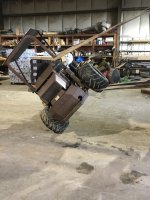AxleHub
Elite Member
4570,
Its. good you are happy with your equipment choices
Its. good you are happy with your equipment choices
R3 turf tires are better on slopes and sidehills for your area/lawn? I can't hold a mower (slope or sidehill) on my hills with R3's. When I tested mowers with R3's (Scag and GH) I slid down and lost control even when it was dry. If I did get traction to climb, I couldn't stop and restart while going up the hill without spinning. Bar tires with low pressure made all the difference for my area.4570,
That was a similar statement the Grasshopper salesman made when he stopped out to demo a unit (a front mount). He ended up in the neighbors yard twice and almost in the drainage ditch once.
I'm amazed how much some people don't understand the grass type and sidehills are a combined issue. I've always liked the bigger front mount grasshoppers for slope . . . But sidehills is a different story. As is the need for using r3 treaded tires is important too
R3 turf tires are better on slopes and sidehills for your area/lawn? I can't hold a mower (slope or sidehill) on my hills with R3's. When I tested mowers with R3's (Scag and GH) I slid down and lost control even when it was dry. If I did get traction to climb, I couldn't stop and restart while going up the hill without spinning. Bar tires with low pressure made all the difference for my area.
AxleHub, No doubt there are some seriously steep hills that people mow that require specialized equipment like yours. Have you measured the degree of your terrain? How big of an area is your hilled lawn? I like to see some of the differences that we all deal with during our weekly mowing rituals.
A bit of slope comparison videos. Power Trac 1850 vs. Kut Kwick Slopemaster - YouTube
